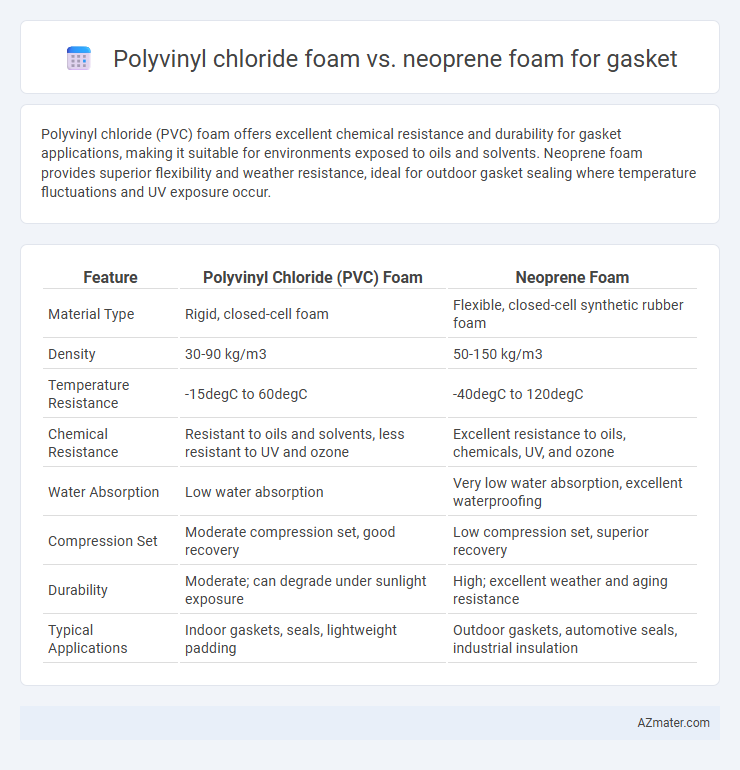Polyvinyl chloride (PVC) foam offers excellent chemical resistance and durability for gasket applications, making it suitable for environments exposed to oils and solvents. Neoprene foam provides superior flexibility and weather resistance, ideal for outdoor gasket sealing where temperature fluctuations and UV exposure occur.
Table of Comparison
| Feature | Polyvinyl Chloride (PVC) Foam | Neoprene Foam |
|---|---|---|
| Material Type | Rigid, closed-cell foam | Flexible, closed-cell synthetic rubber foam |
| Density | 30-90 kg/m3 | 50-150 kg/m3 |
| Temperature Resistance | -15degC to 60degC | -40degC to 120degC |
| Chemical Resistance | Resistant to oils and solvents, less resistant to UV and ozone | Excellent resistance to oils, chemicals, UV, and ozone |
| Water Absorption | Low water absorption | Very low water absorption, excellent waterproofing |
| Compression Set | Moderate compression set, good recovery | Low compression set, superior recovery |
| Durability | Moderate; can degrade under sunlight exposure | High; excellent weather and aging resistance |
| Typical Applications | Indoor gaskets, seals, lightweight padding | Outdoor gaskets, automotive seals, industrial insulation |
Introduction to Gasket Materials
Polyvinyl chloride (PVC) foam offers excellent chemical resistance and durability, making it ideal for gaskets in harsh environments where exposure to oils, solvents, and moisture is common. Neoprene foam provides superior flexibility, weather resistance, and compressibility, which ensures effective sealing in dynamic applications subjected to temperature fluctuations and mechanical stress. Selecting between PVC and Neoprene foam for gasket materials depends on specific requirements such as environmental exposure, mechanical properties, and sealing performance.
Overview of Polyvinyl Chloride (PVC) Foam
Polyvinyl chloride (PVC) foam is a lightweight, closed-cell material known for its excellent chemical resistance, high durability, and good thermal insulation properties, making it a popular choice for gasket applications in automotive, construction, and industrial settings. Its resistance to moisture, oils, and solvents ensures long-lasting seals, while its compressibility allows effective vibration dampening and noise reduction. Compared to neoprene foam, PVC foam offers superior dimensional stability and environmental resistance, making it ideal for outdoor and harsh conditions.
Overview of Neoprene Foam
Neoprene foam is a highly durable synthetic rubber known for its excellent chemical resistance, weathering stability, and superior flexibility, making it ideal for gasket applications in harsh environments. It provides effective sealing against oils, solvents, and temperature fluctuations, outperforming Polyvinyl chloride (PVC) foam in resilience and longevity. Its closed-cell structure also ensures low water absorption and strong cushioning properties, contributing to reliable gasket performance in automotive, industrial, and marine sectors.
Key Physical Properties Comparison
Polyvinyl chloride (PVC) foam offers excellent rigidity, chemical resistance, and durability, making it ideal for gasket applications requiring structural support and resistance to oils and solvents. Neoprene foam provides superior flexibility, weather resistance, and compressibility, which enhances sealing performance under varying temperature and pressure conditions. When comparing key physical properties, PVC foam typically has higher tensile strength and hardness, while neoprene foam excels in elasticity and resistance to ozone and UV degradation.
Chemical Resistance: PVC Foam vs Neoprene Foam
Polyvinyl chloride (PVC) foam exhibits outstanding chemical resistance against acids, alkalis, and oils, making it suitable for gaskets exposed to harsh industrial chemicals. Neoprene foam offers excellent resistance to weathering, ozone, and some oils but is less resistant to strong acids and solvents compared to PVC foam. For gasket applications requiring prolonged exposure to aggressive chemicals, PVC foam generally provides superior chemical stability and durability over neoprene foam.
Durability and Longevity Considerations
Polyvinyl chloride (PVC) foam gaskets offer excellent chemical resistance and UV stability, making them highly durable in outdoor and harsh industrial environments. Neoprene foam gaskets provide superior flexibility and moderate resistance to oils and weathering, yet may degrade faster under prolonged exposure to ozone and sunlight. For long-term applications requiring strong resistance to environmental factors, PVC foam generally ensures greater longevity and consistent gasket performance.
Temperature and Weather Resistance
Polyvinyl chloride (PVC) foam gaskets exhibit excellent resistance to weathering and moderate temperatures up to around 80degC, making them suitable for outdoor applications with consistent exposure to moisture and UV radiation. Neoprene foam gaskets outperform PVC in temperature endurance, maintaining flexibility and sealing performance between -40degC and 120degC, and offer superior resistance to ozone, oil, and various chemicals. Selection between PVC and neoprene foam gaskets depends on the specific environmental conditions, where neoprene provides enhanced durability in extreme temperatures and harsh weather environments.
Cost Analysis: PVC Foam vs Neoprene Foam
Polyvinyl chloride (PVC) foam offers a cost-effective solution for gasket applications due to its lower raw material and production expenses compared to neoprene foam. Neoprene foam, while providing superior chemical resistance and durability, generally incurs higher costs driven by petroleum-based compounds and complex manufacturing processes. When selecting between PVC and neoprene foam, balancing budget constraints with performance requirements is essential for optimal gasket material choice.
Typical Applications in Gasketing
Polyvinyl chloride (PVC) foam is commonly used in gasketing for automotive seals, electrical insulation, and weather stripping due to its excellent chemical resistance and durability. Neoprene foam excels in applications requiring superior oil, fuel, and ozone resistance, making it ideal for industrial machinery gaskets, refrigeration systems, and marine seals. Both materials provide effective cushioning and sealing, with PVC foam favored for its rigidity and neoprene for its flexibility and resilience under harsh environmental conditions.
Choosing the Right Foam for Your Gasket Needs
Polyvinyl chloride (PVC) foam offers excellent chemical resistance, durability, and is ideal for gaskets exposed to oils and solvents, while neoprene foam provides superior flexibility, weather resistance, and resilience in extreme temperatures. Selecting the right gasket foam depends on application-specific factors such as exposure to chemicals, temperature range, compression set, and environmental conditions. Evaluating properties like density, tensile strength, and weatherability ensures optimized sealing performance and long-term reliability in industrial or automotive gasket applications.

Infographic: Polyvinyl chloride foam vs Neoprene foam for Gasket
 azmater.com
azmater.com